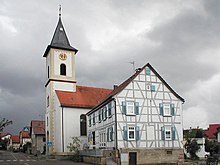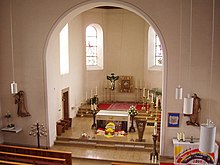St. Georg (Siegelsbach)
The Catholic Church of St. Georg in Siegelsbach is a Catholic church consecrated in 1858. The building, consecrated to Saint George , goes back to the original church of the village, which was reformed in the 16th century and added to the Catholics in 1711 under the then Catholic local rule . After the demolition of the old building, the current building was built in 1858, the interior of which is characterized by renovation measures of the 20th century.
history
Church history
In Siegelsbach there was probably a chapel consecrated to St. George since the beginning of the settlement, which was first mentioned in 1384 and was a subsidiary church of Hüffenhardt in 1476 . The chapel was at the southwest end of the village, which continued in a northeast direction along the main road. The old church had a tower about 22 meters high to which the nave was attached. In the base of the tower was the high altar (presumably facing east). The tower had a stone base about 10 meters high, on top of it a half-timbered storey about 9 meters high and on top of it another wooden structure.
Under the local rule of the Lords of Hirschhorn , Siegelsbach became an independent parish and reformed in the first half of the 16th century , after which Lutheran pastors were in the church in future . During the Thirty Years' War the old church was damaged and then restored. The pastor's post was temporarily unoccupied during the war, and the community became a branch of Haßmersheim , while the purely Lutheran town of Siegelsbach was administered directly by the Electoral Chamber of Accounts of the Electoral Palatinate after the Lords von Hirschhorn died out . In the late 17th century, when the Catholic Elector Philipp Wilhelm took office, Catholics, Lutherans and Reformed people in the Electoral Palatinate were given equal rights.
In 1698 Siegelsbach came to the Elector's Catholic court chancellor, Franz Melchior von Wiser. He and his descendants, the Counts of Wiser, wanted to persuade Siegelsbach to adopt Catholicism and immediately awarded half of the rectory to a Catholic clergyman. Initially, the Catholic community consisted almost entirely of the count's family and their servants, but gradually grew through the acceptance of settlers from Austria, Bavaria and Italy. The church was initially used simultaneously until Count von Wiser expelled the evangelical pastor in 1710 and at the beginning of 1711 completely expelled the evangelicals on punishment from the church. The Protestant community celebrated services in the town hall and built its own church from 1765.
The Catholic parish had meanwhile a rapid change of 16 pastors between 1711 and 1750. The parish was notorious among the pastors as "the worst of the whole diocese of Worms" and as "exilium and purgatory", there was bitter poverty and a "pathetic" parsonage. From 1777 the pastor's post was temporarily unoccupied and was provided by Dominicans from Wimpfen . After 1783 there was a pastor again who, however, had ongoing difficulties with the von Wiser family, who were again living in the village from 1788 and who were also church patrons. After his death in 1802 the position remained vacant again until 1815. The church was already in bad shape in 1783, in 1808 the tower, which had now been tilted sideways, was in danger of collapsing, and master builder Rauschenbach from Obrigheim spoke out in favor of a new building for the entire church, for which, however, no funds were available. The tower was poorly repaired. Because of progressive damage, the church had to be closed by the police on March 10, 1853. Services were held temporarily in the neighboring Catholic school and in the branch church in Heinsheim . The old church was finally demolished in November 1857.
New church building in 1858
The church was rebuilt according to plans by the Rappenau saltworks master Josef Fritschi from April to October 1858. The new church was consecrated on October 26, 1858. The church was no longer east because its choir is in the northwest, while the one in the southeast located, solid stone brick tower is designed as a passage portal. In 1860 a Merklin organ was installed on the gallery opposite the choir .
The church was completely painted in the style of historicism . The painting consisted mostly of floral elements, but also showed figures of saints and angels. The altar and tabernacle were at the head end of the choir, to the left and right of the triumphal arch to the choir were side altars and paintings of saints. The historical furnishings were restored in 1927.
The church initially had a bell cast by Lucas Speck in 1810 , which was supplemented by two more bells in 1887. Although new bells were procured several times, the old bell from 1810 has been in the possession of the community and is now on display next to the church.
Redesign in 1956
In the course of the liturgical reform in 1956, the interior of the church was greatly simplified. The painting was completely removed, the ceilings were partially suspended. On the initiative of pastor Roman Gumbel, who had been appointed from 1962, modern altars, figures of saints, tabernacles, candlesticks, etc. were gradually purchased for the simple interior of the church. The organ was restored in 1983/84.
The side altars were replaced by bronze figures of Mary and Joseph , designed by Gisela Bär in 1971. The same artist also created the Easter candlestick with depictions of the evangelists and figurative decorations on the altar and tabernacle as well as a multi-part depiction of the Stations of the Cross , which was attached to the church walls in 1981.
In 1984 the choir received two stained glass windows by the Neckarsteinach artist Valentin Peter Feuerstein with the depiction of Saint George as a dragon slayer and the Notburga von Hochhausen as a one-armed man. In March 1990 ten more stained glass windows by the same artist with biblical motifs were installed.
During the First and Second World Wars, the two largest bells had to be delivered, for which replacements were procured in 1921 and 1955 respectively. In 1985 and 1987 two more bells were added each, but the small old bell from 1810 was removed. Overall, the church today has a six-part ringing of the following bells: St. Joseph (185 kg) and Queen Mary (510 kg), consecrated on April 19, 1955, St. George (1360 kg) and Notburga (940 kg), consecrated in December 1986, as well as Our Father (1860 kg) and altar sacraments (315 kg), consecrated on October 4, 1987.
Various items of furniture have been preserved in the possession of the community, which adorned the church until it was redesigned in 1956. A historical Pietà was kept in a niche on the right wall, while the statues of Peter and Paul , which were once set up in the choir, found a new place above the side door. An old grave slab is embedded in the base of the tower. The old tabernacle as well as old paintings and figures of saints were stored.
literature
- Rudolf Petzold: Siegelsbach - A home book . Siegelsbach community, Siegelsbach 1986
- Church leader St. Georg Siegelsbach
Web links
Coordinates: 49 ° 16 '4.4 " N , 9 ° 5' 23" E












